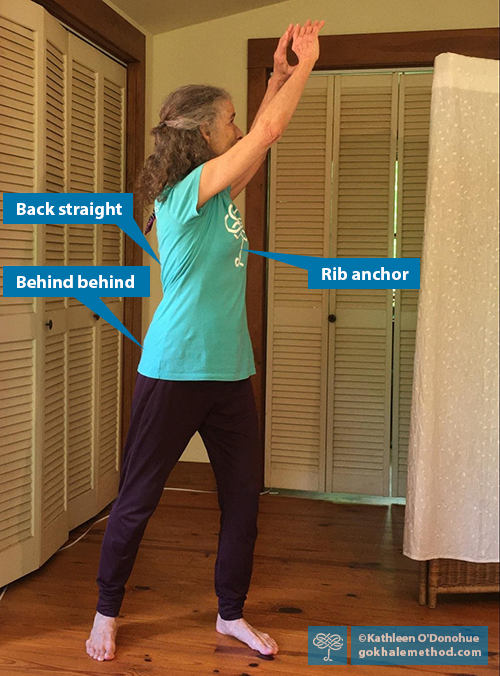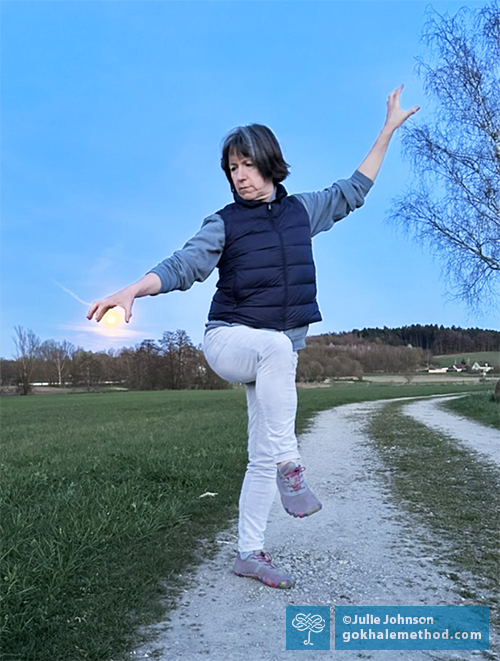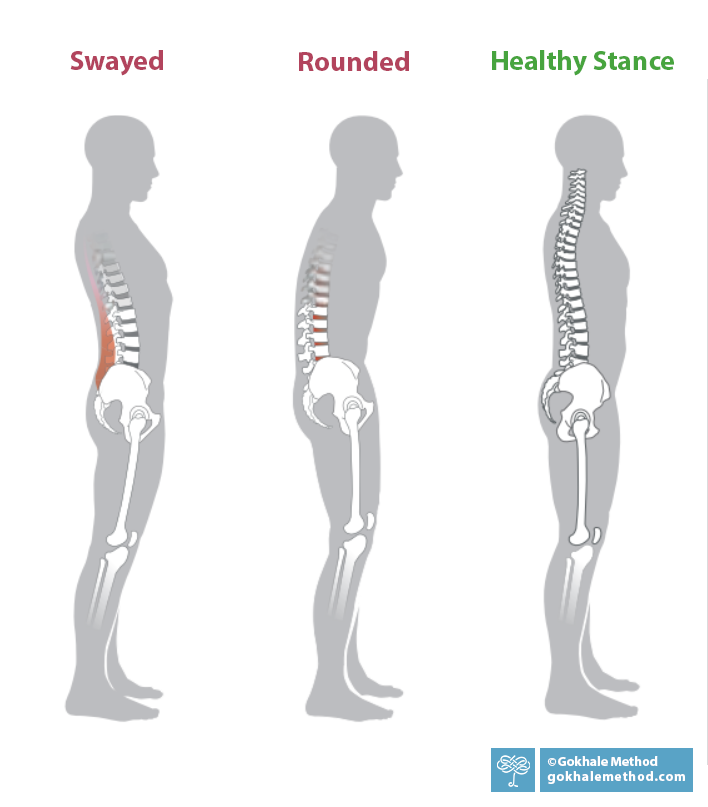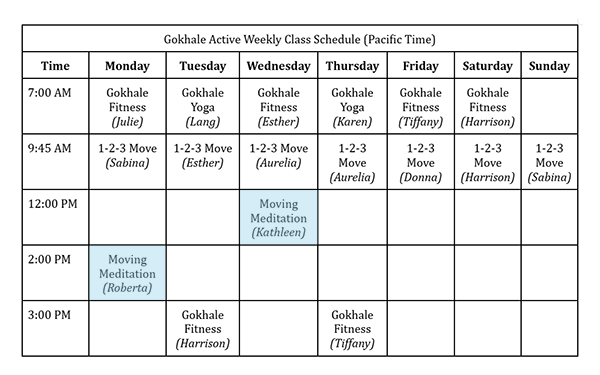Tai Chi, Qigong, and Tucking the Pelvis
Our teachers often field questions about tucking the pelvis for Tai Chi and Qigong. It is frequently perceived that Tai Chi recommends tucking the pelvis as part of a baseline stance, purportedly to facilitate “the Qi to flow unimpeded.” It’s a central tenet in Gokhale Method® philosophy that the baseline pelvic position be anteverted, and that tucking the pelvis is a “wrong turn” Western society took about a century ago (think flapper posture). So students who encounter a seemingly exactly opposite guideline or model in Tai Chi are understandably confused.
We have three qualified Tai Chi/Qigong teachers in our teacher community, including Kathleen O’Donohue and Roberta Cooks, who teach the Moving Meditation sessions of our Gokhale® Active program, and Julie Johnson, who teaches in her hometown, Öhringen, in Germany. My experience of Tai Chi was while studying TCM acupuncture in Nanjing, China in 1989. Lang Liu, though not a Tai Chi teacher, teaches Gokhale Active Yoga and has practiced another martial art, Capoeira, for many decades. We teachers have discussed our experiences and the apparent discrepancies in “tucking” guidelines in detail.
Kathleen is the most experienced of the trio of Gokhale Method teachers who have also taught Tai Chi or Qigong. Kathleen started learning Tai Chi in 1985 with her teacher Professor Chi, Quan Wen, and has this to say:
My first teacher had fled mainland China to Taiwan, where he was taught by the eminent teacher Cheng Man-Ch’ing. He taught in Chinese, with one student occasionally translating into English. We did not need a translation into English for his jokes, we just joined in his infectious laughter because he was so funny, and such a sweet man. The point of recalling this history in detail is that I was never, ever, taught to tuck the pelvis. He didn’t demonstrate tucking; he didn’t correct any of us to tuck. The first place I heard tucking mentioned in relation to Tai Chi was in a question from a Foundations student when I was in training here in Palo Alto. The baseline position I was taught is similar to the “ready position” the Gokhale Method teaches as a first pass in standing.
My second teacher was Dr Paul Lam, founder of the Australia-based Tai Chi for Health Institute. He did not teach tucking either. I therefore questioned the instruction to tuck I was once given in a recertification class. The master trainer I asked confirmed that tucking the pelvis is not taught, and recognized it as an area of confusion. In Tai Chi we often imagine the life force emanating from the depth of the abdomen through the mid back and going forward through the limbs, which could perhaps get misinterpreted as including tucking the pelvis for flow to the legs.

Kathleen finds harmony between Tai Chi and the Gokhale Method.
Roberta studied Argentine Tango dancing and practiced many kinds of mindful meditation before she trained as a Tai Chi teacher. She explains:
My formative experiences included Medical Qigong with Dr. Roger Jahnke, and Wisdom Healing Qigong with Master Mingtong Gu. By chance, I then found a Tai Chi Chih class at my local YMCA. This form was developed in the US by Justin Stone, a Tai Chi Chuan Master, who created a gentle practice that could be learned relatively easily by people of all ages and abilities. It is made up of 19 movements and a final pose.
Justin Stone passed away in 2012. Through photographs and videos of his movements, it is evident that he maintained a J-spine in his practice. Most of the people he mentored who became Tai Chi Chih teachers practice Tai Chi Chih with an anteverted pelvis. However, at least one of the Tai Chi Chih teachers in my teacher training course has not followed the example of his mentor and practices the movements with a tucked pelvis. He also teaches his students and teacher trainees to follow his example, which was uncomfortable for me when I took a class with him. It is interesting to note that this particular teacher also suffered from back pain. Sometimes, the knowledge of a Qigong master can get distorted as it passes from teacher to student.
Recently qualified as a teacher of Qigong, Gokhale Method teacher Julie shares her experience:
I have been practicing Shaolin Qigong for the past 10 years. It is a practice which goes back thousands of years and is rooted in Chinese philosophy and the I-Jing. Qi means energy and Gong means work. The practice is mainly done standing; an emphasis on slow, gentle movements and breath work enables us to feel our energy, develop it, and channel it. It is a great way to practice healthy posture whilst calming the mind and body. Like me, my students often report sleeping like a log after practice!
My Chinese teacher Shi Xinggui has a very clear J-spine. He cannot explain the principles to his students in their language, but throughout his practice we see his behind behind and his relatively straight lumbar spine.

Julie shows that lifting a leg does not mean tucking the pelvis under. Tucked posture and tight hamstrings and hips often result in that habit.
Lang has an interesting personal insight into the question of tucking the pelvis and pelvic angle, which is valuable to our discussion. Lang tells her story:
My father is of Chinese extraction, and like many East Asians, he has a small degree of curvature at L5-S1. When I enrolled in the Gokhale Method Foundation Course as a student over 10 years ago, the teacher mistakenly assumed that I was tucking—and so did I! It took me many months of experimenting (including sticking out my behind and giving myself terrible lower back pain) to realize that I did not in fact tuck when standing, only when sitting. The “stiffness” at L5-S1 that I assumed was present turned out to not be stiffness, but rather my natural structure!
While this experience was frustrating, it taught me a great deal both as a student of posture and a Gokhale Method teacher. I realized that there is an enormous amount of variation in human beings’ L5-S1 angle! As I began to observe people around me in multicultural Toronto, I noticed that healthy pelvises and spines can look quite different in different ethnic groups. I also realized that confusion abounds around healthy pelvic position: For example, I met non-Asian students with sharp L5-S1 angles who practiced Tai Chi, ballet, and other art forms, who had been taught to tuck because their behinds were deemed “too prominent”. While some did have a pronounced sway, others had beautiful J-spines—their “behinds” simply did not match the teacher’s idea of normal!
As Gokhale Method teachers, we have come a long way in fine-tuning our understanding of the ideal pelvic position of each person we encounter.
In summary, people tuck their pelvis because:
1. They misinterpret authentic East Asian teachings.
2. They are trying to compensate for overcontracted muscles of the lumbar spine (a “sway back”, “arching,” “lordosis”.)

A tight, swayed lower back (left) is often misguidedly stretched out by tucking the pelvis and rounding the back (center). A healthy stance (right) requires a realignment of the whole skeleton, as taught in our in-person Foundations course, one-day Immersion course, our online Elements course, plus our Gokhale Active program.
If you are reluctant to second guess a respected teacher who teaches tucking the pelvis, or believe in some positive value of tucking in a particular context, consider returning to a more natural baseline in the rest of your activities. It is important to recognize that what might be taught in a particular practice doesn’t necessarily benefit or belong in your everyday life. Sustained tucking can put pressure on the front of the lumbar discs, especially the wedge-shaped L5-S1 disc, causing it to bulge or even herniate back towards the spinal nerve roots.

This diagram of the lower vertebrae, discs, and sacrum, shows why tucking the pelvis and pulling your “tail” under can do damage to the lower discs and the nerves behind them.
We hope you are inspired to try out one of our healthy posture Moving Meditation classes. Our class schedule is below. See you there!

Best next action steps
If you would like help with finding healthy posture in your activities, get started by booking a consultation, online or in person, with one of our teachers.
You can sign up below to join any one of our upcoming FREE Online Workshops…

Comments
The recommendation in Tai…
The recommendation in Tai Chi to tuck in the pelvis fundamentally stems from its nature as a martial art, where the concepts of attack and defense take precedence. As such, it naturally differs from postural concepts intended for everyday life.
The primary cause of modern spinal disorders appears to be the failure to adopt an upward-gaze posture, despite the fact that the head's center of mass—even when looking straight ahead (Frankfurt horizontal plane)—is tilted forward by approximately 18.5 degrees from the center of the top surface of the first cervical vertebra (C1).
Add New Comment
Login to add commment
Login